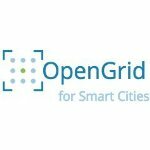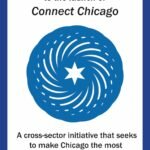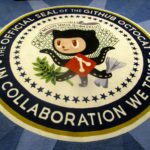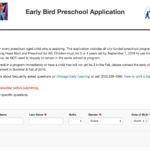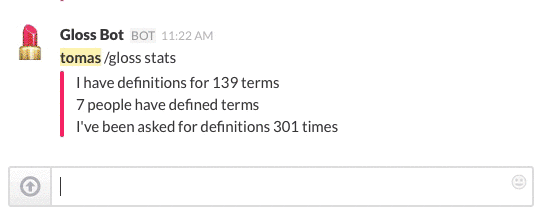 One of the quirks of both working in technology and the civic sectors is that both sectors tend to use a lot of jargon and abbreviations that makes perfect sense in context, but can baffle outsiders.
One of the quirks of both working in technology and the civic sectors is that both sectors tend to use a lot of jargon and abbreviations that makes perfect sense in context, but can baffle outsiders.
As an organization that believes in collaboration, we end up doing spending a lot of time translating and explaining the jargon. Christopher Whitaker’s Civic Hacking 101 is specifically designed to do exactly this.
Our partner, Code for America, has developed a tool for Slack called Glossbot. Glossbot is a simple web app designed to be used as a Slack integration. Code for America uses this to define the jargon it comes across as they work so when they’re discussing their work everyone can be caught up on the definitions. Of course, this information is also useful for other civic technologists who run across these terms as well.
We’ve take a data dump from the bot and edited it to exclude some California things and add some Chicago things. You can see the raw information here. If your team uses Slack, you can also deploy your own Glossbot by forking the code on Github. If you’re looking for something in particular, you can also search by hitting (Ctrl+F on Windows or Command+F on a Mac)
- 18f – A group within the U.S. General Services Administration that builds digital services for government.
- ACCDB – A Microsoft Access database format.
- ADA – American with Disabilities Act; a set regulations regarding hiring practices, building codes, and other regulations aimed at reducing discrimination towards disabled people.
- AFDC – Aid to Families with Dependent Children, a federal assistance program in effect from 1935 to 1996 created by the Social Security Act and administered by the U.S. Department of Health and Human Services that provided financial assistance to children whose families had low or no income. Replaced by the Temporary Assistance for Needy Families (TANF) program.
- AMD – Asynchronous Module Definition; a mechanism for defining JavaScript modules such that the module and its dependencies can be asynchronously loaded.
- ANT -Actor-Network Theory, an approach to social theory and research, originating in the field of science studies, which treats objects as part of social networks.
- API – Application Programming Interface, an interface that exposes the data and functionality of an application to other applications.
- AWS – Amazon Web Services. People can use AWS to host their website on Amazon’s cloud servers instead of their own physical ones. Smart Chicago also provides free hosting to Chicago civic apps.
- bikeshedding – Parkinson observed that a committee whose job is to approve plans for a nuclear power plant may spend the majority of its time on relatively unimportant but easy-to-grasp issues, such as what materials to use for the staff bikeshed, while neglecting the design of the power plant itself, which is far more important but also far more difficult to criticize constructively.
- BLUF – Bottom Line Up Front, a paragraph where conclusions and recommendations are placed at the beginning of the text, rather than the end, in order to facilitate rapid comprehension.
- Broadband – Commonly referred to as High Speed Internet; The FCC has recently updated its definition of broadband to 25 megabits per second (Mbps) for downloads and 3 Mbps for uploads.
- CBO – Community-Based Organization or the Congressional Budget Office
- CFPB Consumer Financial Protection Bureau, an independent agency of the United States government responsible for consumer protection in the financial sector.
- City Analytics Dashboard – A CfA app that displays live activity on a web site via Google Analytics
- Clean – An app built by Code for America’s Health Lab to simplify and accelerate the process of applying for CalFresh.
- CMS – Content Management System used by websites which publish a lot of content. A good example of this is WordPress or Centers for Medicare and Medicaid Services
- CRM – Customer Relationship Management used by organizations that have a large sales function or non-profits that deal with a lot of funders or grantees. Salesforce is an example.
- CUTgroup – Civic User Testing Group, a set of regular Chicago residents who get paid to test out civic apps. This program has been duplicated in other cities such as Oakland.
- Digital Services Census – The Local Digital Services Census surveys the quality and usability of the 10 most searched-for city services, as identified from research by the Code for America Tech Team.
- DSL – Domain-Specific Language
- EBT – Electronic Benefit Transfer, the system used in by states for the delivery, redemption, and reconciliation of issued public assistance benefits. EBT cards go by different names in different states.
- EHR – Electronic Health Record
- eRegs eRegulations, a web-based application that makes regulations easy to find, read and understand, developed by the Consumer Financial Protection Bureau.
- ESL – English as a Second Language
- ETL – Extract, Transform, Load. The process that developers and data scientists use to extract data from one system, transform it, and load it into a different system. Cities like Chicago use this to take data from their business systems and load it into the data portal automatically. For a complete guide on ETL, click here.
- FEC – Federal Election Commission, an independent regulatory agency which regulates campaign finance legislation.
- FPL – Federal Poverty Level
- FOIA – Freedom of Information Act Request; Legal method used to get information from governments. Can be time consuming.
- GDS – Government Digital Service; An agency in the United Kingdom, the Government Digital Service is leading the digital transformation of government, making public services digital by default, and simpler, clearer and faster to use. The GDS provided the inspiration for the US’s 18F and USDS.
- GIS – Geographic Information Systems; Software used to display geographic data such as ArcGIS. This term used to reference software made by ESRI, but now can refer to everything from Google Maps, to OpenStreetMap, to CartoDB.
- GitHub – A web service used to host repositories of code and make it easier for developers to collaborate using open source.
- GovDelivery – A marketing and communications firm that works with federal, state and local governments on email marketing campaigns and mailing list management.
- Govtech Fund – A venture capital fund dedicated to government technology startups.
- GSA the U.S. General Services Administration, an independent agency of the United States government, established to help manage and support the basic functioning of federal agencies.
- HIMSS – Healthcare Information and Management Systems Society
- HIPAA- the Health Insurance Portability and Accountability Act, U.S. legislation that ensures a person’s right to buy health insurance after losing a job, establishes standards for electronic medical records, protects the privacy of a patient’s health information, and gives patients the legal right to access their own health data.
- IPHI – Institute for Public Health Innovation
- Javascript – Javascript is a programming language used by web browsers. It is not the same as Java which is a whole other language.
- LAF / Legal Aid Foundation – A non-profit organization that often does pro-bono work representing clients who can’t afford legal counsel. See LAF Chicago.
- LEP – Limited English Proficient
- MindMixer – A platform allowing local governments to solicit ideas from their communities and support a process for implementing the best ones. A CfA 2012 Accelerator company.
- MOE – Maintenance Of Effort, often refers to requirements that a government must meet to continue participating in a federal program.
- Meaningful Use – Medicare and Medicaid EHR Incentive Programs provide financial incentives for the “meaningful use” of certified EHR technology. To receive an EHR incentive payment, providers have to show that they are “meaningfully using” their certified EHR technology by meeting certain measurement thresholds that range from recording patient information as structured data to exchanging summary care records.
- NDoCH – National Day of Civic Hacking
- NNIP – The National Neighborhood Indicators Partnership (NNIP) is a collaborative effort by the Urban Institute and local partners to further the development and use of neighborhood information systems in local policymaking and community building.
- NSTIC – National Strategy for Trusted Identities in Cyberspace, a White House initiative to work collaboratively with the private sector, advocacy groups, public sector agencies, and other organizations to improve the privacy, security, and convenience of online transactions.
- Ohana API – An API that provides any city or county with an open-source framework for opening up a dataset of community-based organizations, and keeping the information up to date. A 2013 San Mateo Fellows project.
- ONC – Office of the National Coordinator for Health Information Technology. Part of the U.S. Department of Health and Human Services, purpose is to support the adoption of health information technology and the promotion of nationwide health information exchange to improve health care.
- Open Data – Open data refers to data often released by governments that adheres to the 8 Principles of Open Data.
- Open Source – Open source software is software that can be freely used, changed, and shared (in modified or unmodified form) by anyone. Open source software is made by many people, and distributed under licenses that comply with the Open Source Definition.
- OSTP – White House Office of Science and Technology Policy
- PIF – Presidential Innovation Fellows <https://18f.gsa.gov/pif/>
- R – R is a free software environment for statistical computing and graphics. It’s used by data scientists to analyze data.
- Ruby – A dynamic, open source programming language with a focus on simplicity and productivity. Often used in conjunction with Ruby on Rails
- Ruby on Rails – Ruby on Rails is an open-source web framework written in Ruby. It was created in Chicago from work that David Heinemeier Hansson was doing for Basecamp.
- SMS – Short Messaging Service, a text messaging service component of phone, Web, or mobile communication systems. It uses standardized communications protocols to allow fixed line or mobile phone devices to exchange short text messages.
- SNAP – the Supplemental Nutrition Assistance Program. This program is sometimes known as food stamps or by the name of the card that people use to get benefits such as LINK or CalFresh.
- SSI – Supplemental Security Income, a Federal income supplement program funded by general tax revenues.
- Streetmix – An interactive street section builder that helps community members mockup the streets they’d like to live on and offer these mockups as future plans for city officials and planners. Built by 2013 fellows.
- Streetsblog – A transportation blog covering transportation and bike issues.
- TANF – Temporary Assistance for Needy Families, a federal program providing cash assistance to indigent families with dependent children through the U.S. Department of Health and Human Services. Replaced the Aid to Families with Dependent Children (AFDC) program.
- Twilio – A web service used to give apps the ability to send and receive texts.
- USDA – United States Department of Agriculture
- UI – User interface; the parts of the website or app that users use to get the information or results they want.
- UX – User Experience; Generally referring to designing website and applications to make the user experience simple and easy to use. Often means getting apps in front of real users.
- WIC – Women, Infants and Children Program, a federally-funded health and nutrition program that helps families by providing checks for buying healthy supplemental foods from WIC-authorized vendors, nutrition education, and help finding healthcare and other community services.
- WordPress – WordPress is a blogging platform that can be used as a content management system for websites. It’s ease of use makes it a popular platform.
